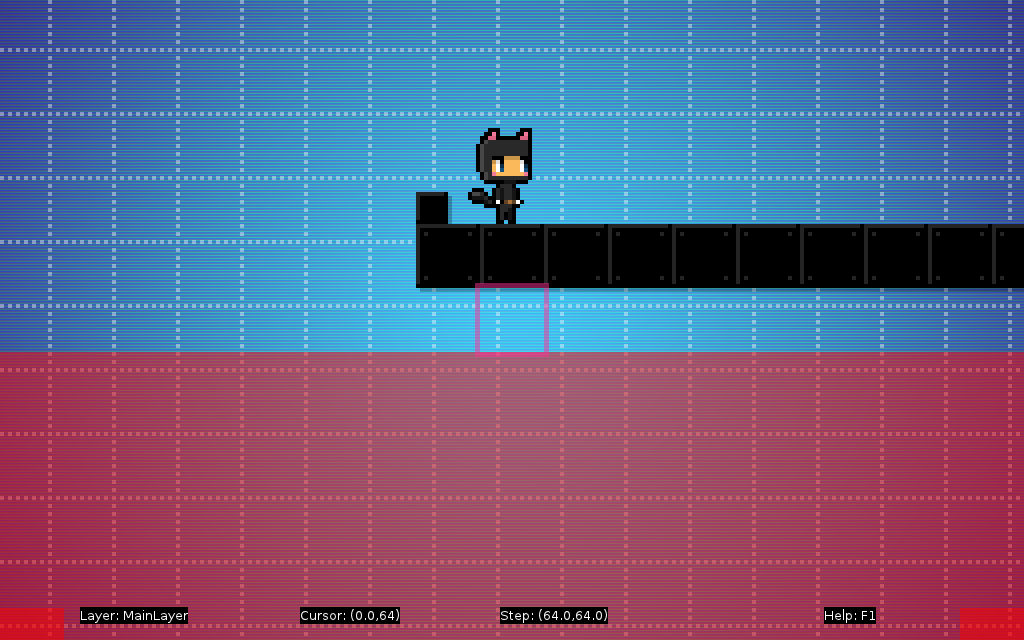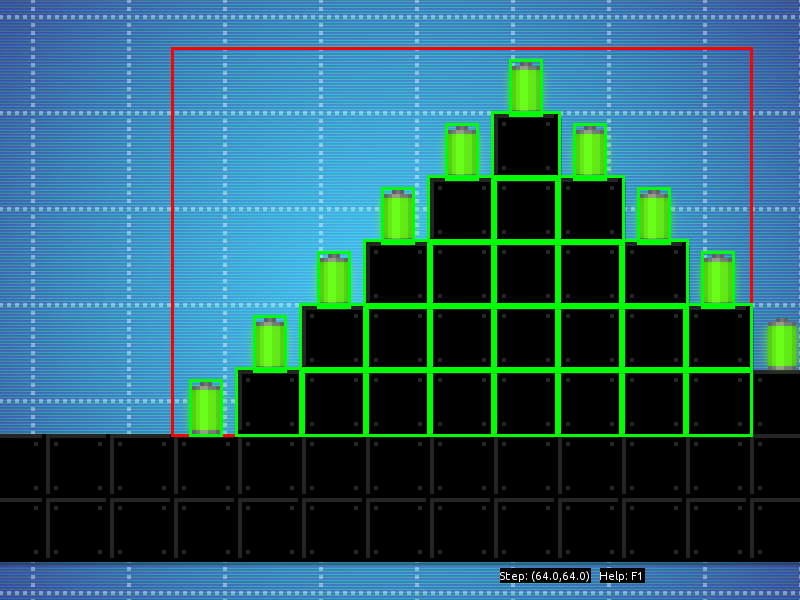Now we'd like to introduce some of the more or less advanced functions. Let's start out with the “Lower Limit”. By default, the levels have no boundry towards the bottom. If you fall, you will fall forever. The
LOWER LIMIT (AKA DEATH ZONE)

Placing the Lower Limit
By the way, robots that are below the “Lower Limit” can not be controlled via terminals, but they are not completely lost either. For example, a platform robot can follow a path with nodes above as well as below the limit.
SELECTION MODE
The selection mode can be used to copy, paste or delete all objects contained in a highlighted area. To start the selection mode, you can either- access it from the editor menu or simply hit SPACE on the keyboard. Then, move the cursor to create a rectangle around the area that you want to select and choose from the following:
- Press C to copy all highlighted objects to the clipboard.
- Press X to cut all highlighted objects to the clipboard.
- Press SHIFT to delete all highlighted objects.
- Use ESC to access these options from a menu (or to select EXIT SELECTION MODE without doing anything...)

Selecting multiple blocks and batteries
Having copied or cut objects to the clipboard, you can then paste them anywhere by pressing V. By the way, the selection mode only affects objects in the current layer, but they can be pasted to other layers as well.
LAYERS
Which brings us to layers. First, there is the MainLayer, where all the action happens. This is the default layer, where you place Nikki, the robots, the terminals, physics objects and so on. Everything that will collide with Nikki or other objects.
Additionally you can add any number of background layers, which are rendered in the background. In our example above (started from the template BLUEWITHGRID) there already is one background layer containing the blue background as well as the grid. To add a background layer you choose EDIT LAYERS > ADD BACKGROUND LAYER from the editor menu. The new layer will be inserted between the MainLayer and the foremost background layer.
Further, you can also add foreground layers. These are just like the background layers, but – well – in the foreground. To add a foreground layer you choose EDIT LAYERS > ADD FOREGROUND LAYER. The new layer will be inserted between the MainLayer and the back most foreground layer.
To cycle between the layers in your scene, you press the + and - keys.
Layers can be used to create objects that Nikki will disappear behind or objects that Nikki will walk in front of. Further, layers can be used to achieve the illusion of visual depth, often referred to as multilayer scrolling or parallax scrolling. You can set a specific distance for each layer, which will affect the speed of the layer as the camera moves around the scene. Switch to the layer that you want to edit and then choose EDIT LAYERS > CHANGE LAYER DISTANCE. You will be asked to enter an x-distance affecting the horizontal movement and then to enter a y-distance affecting the vertical movement.
These are some typical values, for example:
- 1 – same speed as MainLayer
- 0 – static background
- 0.5 – half the speed as MainLayer (usually only for multilayer backgrounds)
- above 1 – faster than MainLayer (usually only for multilayer foregrounds)
Here are some more notes, so you won’t get confused:
- When working with layers, be careful to switch to the correct layer before placing or editing anything!
- Layers that are further in the foreground than the current layer will become invisible, so that your view won’t get obstructed.
- When using different distances for the layers, the actual offset of each layer will always be displayed correctly. This results in the camera visually jumping to another point when switching layers, although the cursor coordinates actually remain the same.
OK, that’s it for this tutorial. Thanks for reading and we hope it will be helpful. Please keep in mind that the game is still in alpha stage and some functionality is likely to change. We will be looking to it, that there won’t be too many compatibility issues. But we can’t guarantee for sure that every level that you are building right now will still be working exactly the way you intended in the final release. We hope, you understand. That said, have fun with the editor!
Best wishes, Joyride Laboratories
Check out the compendium for more info on robots! A monolithic tutorial is available here.

